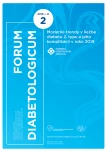Pleiotropic (antiatherogenic) effects of PCSK9 inhibition. Yes or not?
Authors:
Ubomíra Fábryová
Authors‘ workplace:
Metabol KLINIK s. r. o., Ambulancia pre diabetológiu, poruchy látkovej premeny a výživy, Špecializovaná lipidologická ambulancia, MED PED centrum, Bratislava
1; Biomedicínske centrum SAV, Bratislava
2
Published in:
Forum Diab 2019; 8(2): 153-155
Category:
Overview
PCSK9 inhibitors (iPCSK9) prevent the degradation of LDL receptors caused by PCSK9, resulting in not only a substantial reduction (about 60%) of serum LDL-C concentration, but also a clinically significant reduction in acute cardiovascular events. However, the reduction in cardiovascular risk is beyond the expected benefit of LDL-C reduction. Currently, there is a growing evidence on the effect of PCSK9 and PCSK9i on the development of atherosclerosis and also on other metabolic pathways. The pleiotropic effects of PCSK9 inhibition, although not yet fully elucidated at the molecular level, certainly deserve our attention.
Keywords:
Atherosclerosis – alirocumab – evolocumab – PCSK9 inhibitors – pleiotropic effects
Sources
- Fábryová Ľ. Inhibítory PCSK9 v manažmente pacientov s vysokým kardiovaskulárnym rizikom – efektívna liečba na dosah. AtherRew 2016; 1(1): 48–54.
- Abifadel M, Varret M, Rabes JP et al. Mutations in PCSK9 cause autosomal dominant hypercholesterolemia. Nat Genet 2003; 34 (2):154–156. Dostupné z DOI: <http://doi: 10.1038/ng1161>.
- Fábryová Ľ. Otvorené otázky z kardiovaskulárnych štúdií FOURIER a ODYSSEY Outcomes. AtheroRev 2018; 3(3): 209–212.
- Sabatine MS, Giugliano RP, Keech AC et al. Evolocumab and clinical outcomes in patients with cardiovascular disease. N Engl J Med 2017; 376(18): 1713–1722. DOI: <http://dx.doi.org/10.1056/NEJMoa1615664>.
- Schwartz GG, Steg PG, Szarek M et al. Alirocumab and Cardiovascular Outcomes after Acute Coronary Syndrome. N Engl J Med 2018; 379:2097–2107. Dostupné z DOI: <http://doi:10.1056/NEJMoa1801174>.
- Filippatos TD, Christopoulou EC, Moses SE. Pleiotropic effects of proprotein convertase subtilisin/kexin type 9 inhibitors? Curr Opin Lipidol 2018; 29: 333–339. Dostupné z DOI: <http://doi:10.1097/MOL.0000000000000523>.
- Silverman MG, Ference BA, Im K et al. Association between Lowering LDL-C and Cardiovascular Risk Reduction among Different Therapeutic Interventions: A Systematic Review and Meta-analysis. JAMA 2016; 316(12): 1289–1297. Dostupné z DOI: <http://doi: 10.1001/jama.2016.13985>.
- Karagiannis AD, Liu M, Toth PP et al. Pleiotropic Anti-atherosclerotic Effects of PCSK9 Inhibitors From Molecular Biology to Clinical Translation 2018; 20(4): 20. Dostupné z DOI: <https://doi.org/10.1007/s11883–018–0718-x>.
- Adorni MP, Cipollari E, Favari E et al. Inhibitory effect of PCSK9 on ABCA1 protein expression and cholesterol efflux in macrophages. Atherosclerosis 2017; 256: 1–6. Dostupné z DOI: <https://doi: 10.1016/j.atherosclerosis.2016.11.019>.
- Ding Z, Liu S, Wang X et al. Cross-talk between LOX-1 and PCSK9 in vascular tissues. Cardiovasc Res 2015; 107(4): 556–567. Dostupné z DOI: <http://doi: 10.1093/cvr/cvv178>.
- Ding Z, Liu S, Wang X et al Hemodynamic shear stress via ROS modulates PCSK9 expression in human vascular endothelial and smooth muscle cells and along the mouse aorta. Antioxid Redox Signal 2015; 22(9): 760–771. Dostupné z DOI: <http://doi: 10.1089/ars.2014.6054>.
- Ferri N, Tibolla G, Pirillo A et al. Proprotein convertase subtilisin kexin type 9 (PCSK9) secreted by cultured smooth muscle cells reduces macrophages LDLR levels. Atherosclerosis 2012; 220(2): 381–386. Dostupné z DOI: <http://doi: 10.1016/j.atherosclerosis.2011.11.026>.
- Paaciullo F, Momi S, Gresele P. PCSK9 in Haemostasis and Thrombosis: Possible Pleiotropic Effects of PCSK9 Inhibitors in Cardiovascular Prevention. Thromb Haemost 2019; 119(3): 359–367. Dostupné z DOI: <http://doi: 10.1055/s-0038–1676863>.
Labels
Diabetology Endocrinology Internal medicineArticle was published in
Forum Diabetologicum

2019 Issue 2
Most read in this issue
- Modern trends in the treatment of hypertension
- Updates in obesity pharmacotherapy
- Modern trends in local treatment of diabetic foot
- Insulin pump treatment in type 1 diabetes mellitus – for whom and why?
